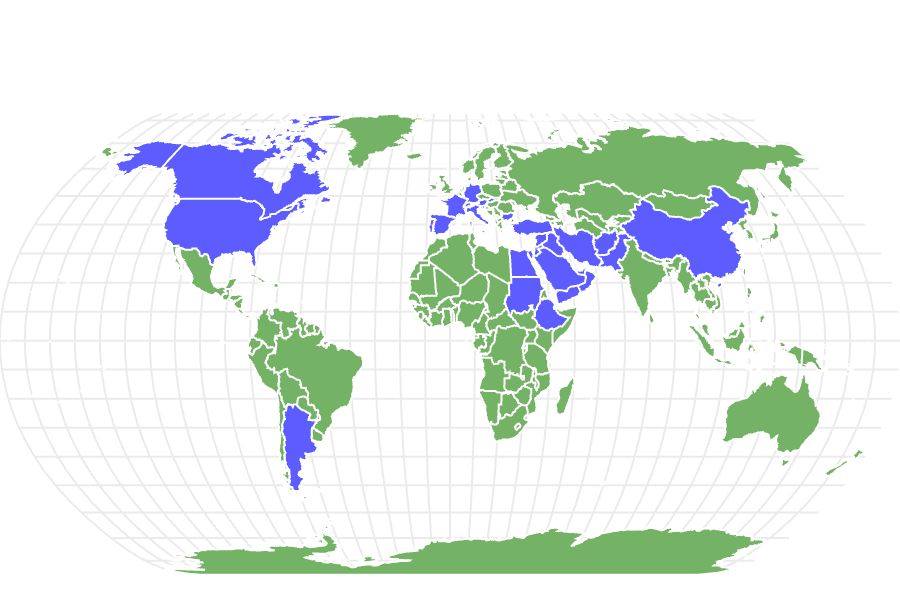Ibex
Can jump over 6 feet straight up from a standstill
Advertisement
Ibex Scientific Classification
Read our Complete Guide to Classification of Animals.
Ibex Conservation Status
Ibex Facts
- Name Of Young
- Kid
- Group Behavior
- Herd
- Fun Fact
- Can jump over 6 feet straight up from a standstill
- Estimated Population Size
- 30,000 for alpine ibex
- Biggest Threat
- Poaching, habitat loss
- Most Distinctive Feature
- Large, curved horns
- Other Name(s)
- Wild goat, steinbock, bouquetin
- Gestation Period
- 168 days
- Litter Size
- 1 - 3
- Habitat
- Cliffs and mountains
- Predators
- Humans, big cats, wolves, eagles
- Diet
- Herbivore
- Type
- Mammal
- Common Name
- Ibex
- Location
- Asia, Europe, Middle East, Africa
Ibex Physical Characteristics
- Color
- Brown
- Grey
- Skin Type
- Hair
- Lifespan
- 20 years
- Weight
- 91 - 120 kg (200 - 270 lbs)
- Height
- 0.69 - 1.09 m (27 - 43 inches)
- Length
- 3.9 ft
- Age of Sexual Maturity
- 18 months
- Age of Weaning
- 4 - 6 months
As one of the main ancestors of the domestic goat, the ibex is a common sight in the mountains of Europe, western Asia, and northeastern Africa.
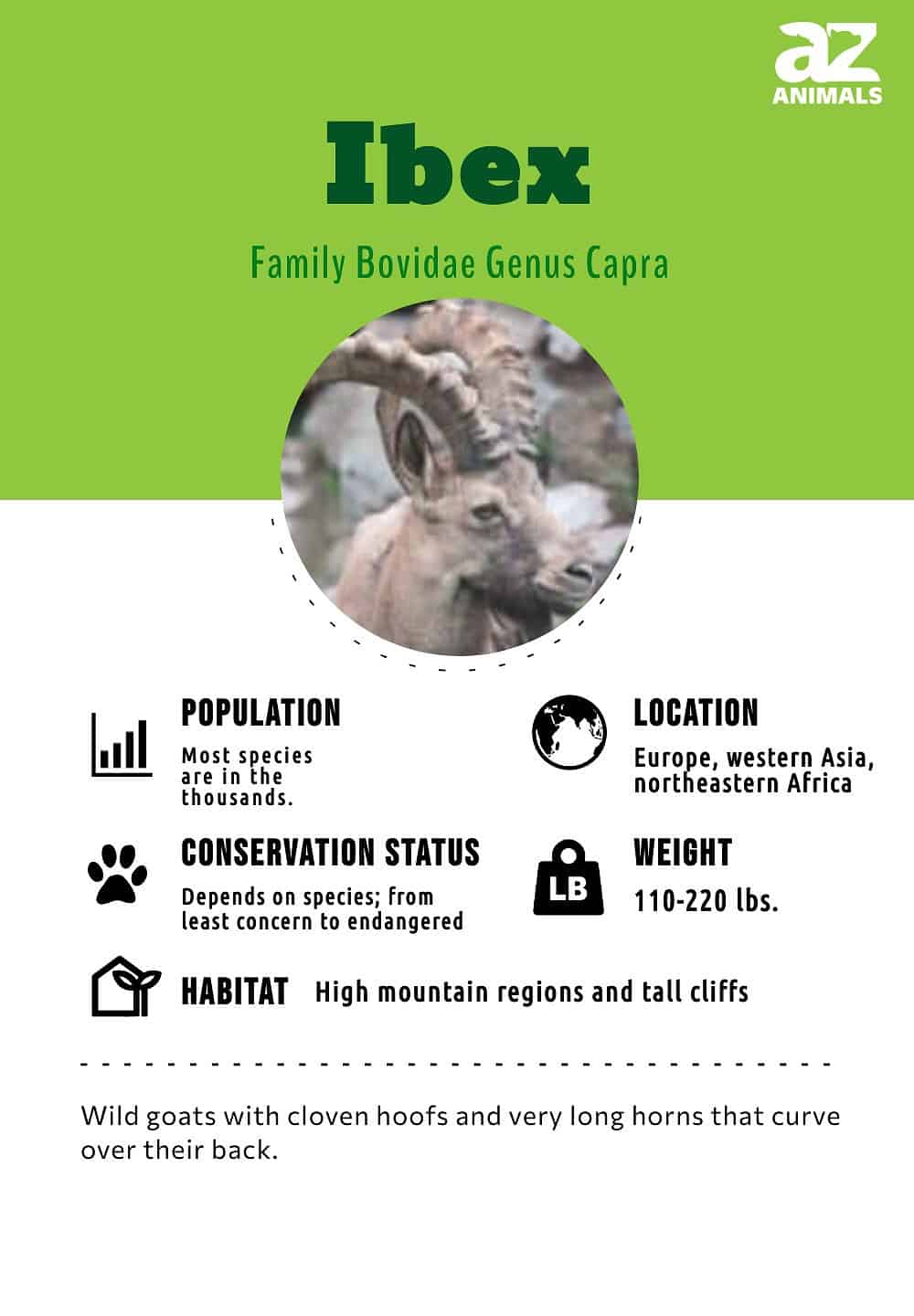
There are five main species, but some data shows as many as eight when counting subspecies. Ibex are wild goats with cloven hoofs and very long horns that curve over their back. Males typically also have beards. The alpine ibex is the most common type, and the Asiatic ibex is generally considered a subspecies.
4 Incredible Ibex Facts!
- The animal’s hooves are sharp with concave undersides to fit the curves of rocks, thus allowing them to climb sheer cliffs with a sense of support.
- The Siberian ibex has the largest horns within the genus at 39-58 inches (100-148 cm).
- Most males and females stay in gender-segregated herds for much of their lives.
- Ibex herds stay close to “escape terrain” in tall cliffs.
Ibex Scientific name
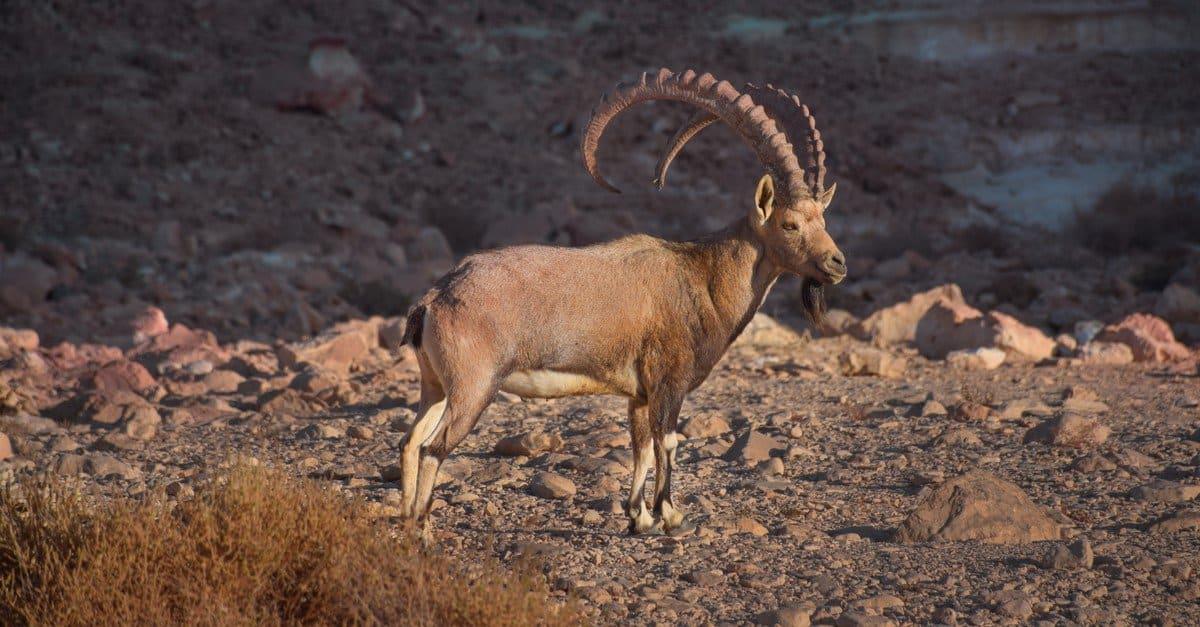
The Nubian ibex is one of the ibex species under the genus Capra.
©SunshineC/Shutterstock.com
These animals belong to the Family Bovidae and Genus Capra. There are a number of species and subspecies, including the following:
- Capra aegagrus aegagrus (Bezoar ibex)
- Capra ibex (alpine ibex)
- Capra nubiana (Nubian ibex)
- Capra walie (Walia ibex)
- Capra pyrenaica (Iberian ibex)
- Capra sibirica (Siberian or Asiatic ibex)
- Capra caucasica (West Caucasian ibex)
- Capra cylindricornis (East Caucasian ibex)
The alpine species is the most commonly referenced species. It is also known by the names of steinbock and bouquetin. The scientific name Capra means goat in Italian.
Historical and archaelogical records show the ibex in existence between 3400-3100 BCE based on remains found in the Italian Alps. There is evidence also from the Near East and Mediterranean regions from about 1800 BCE, then from Afghanistan during the Iron Age (1200-600 BCE). There is a myth that the ibex once had wings, and folklore about it being magical, which may explain its resemblance to the symbol for Capricorn on the zodiac.
Appearance
Most species of these animals have a brown or gray coat. The exact shade and thickness are determined by where they live. For example, the Nubian species have a shiny coat that reflects the sun and helps them keep cool. Nubian ibex are smaller than other species and have slimmer horns. The alpine ibex is a typical example of the species. Adult males weigh around 220 pounds and stand about three feet at the shoulder. Females are about four inches shorter and weigh about half as much at 110 pounds. Males have long horns that curl over their backs. The horns are strongly ridged on the front. Males also have beards.
Behavior

©Martin Pelanek/Shutterstock.com
These animals typically segregate into male herds (bachelor herds) and female herds. The two herds join up only during breeding seasons. Sometimes, older males will wander alone without a herd. Female herds usually have 10 to 20 animals. The animal will usually flee from people, but if it’s rutting season, males can be particularly aggressive and might charge each other.
Habitat
These animals live primarily in high mountain regions and tall cliffs. These habitats make it difficult for predators to get to the animal. The Walia species lives in the highest reaches of the Ethiopian highlands at elevations of up to 14,800 feet. The Nubian ibex is found in the hills around the Red Sea and the Egyptian highlands. The alpine species is found mainly in the European Alps. They can be found in countries like France, Austria, Germany, Bulgaria, Slovenia, Italy, and Switzerland. The Iberian or Spanish ibex lives mainly in the southern Pyrenees on the Iberian Peninsula. It was previously found all through the Pyrenees and in the south of France. The Pyrenean ibex is a subspecies of the Iberian species, and it became extinct by the year 2000. The Pyrenean ibex was later cloned in 2009, but the specimen lived for only ten minutes.
The Siberian or Asiatic ibex is often considered a subspecies of the alpine species, but it may be a distinct species. It enjoys a wide distribution from Afghanistan to Mongolia. The animals are typically found at elevations as high as 17,000 feet above sea level! The Caucasian ibex is also known as the Caucasian tur, and it is found in the Caucasus Mountains at the intersection of Europe and Asia.
The hoof structure of the animal makes it very nimble and skilled at climbing steep rocks. Despite living high in the mountains, the ibex tend to avoid deep snow.
Diet
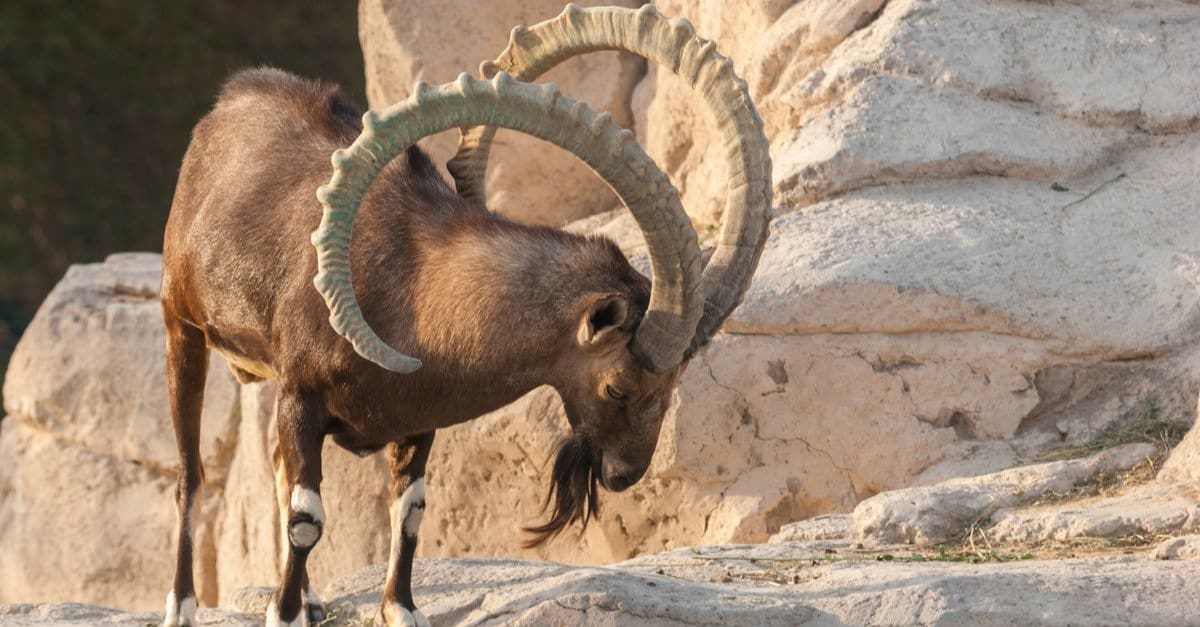
A Siberian ibex (Capra sibirica) may have to come down from steep elevations to avoid deep snows and find food in the winter.
©Photonell_DD2017/Shutterstock.com
All of these animals are herbivores. They only eat vegetation like bushes, grasses, and shrubs. Vegetation high in the mountains tends to have low nutritional value, so the animal spends much of its day eating and grazing. Some of them will also climb into the lower branches of trees to eat leaves. As the animal avoids deep snow, they may come down from the steep elevations in the winter to find food. Herds tend to make sure that their range includes a dependable water source.
Predators and threats
The animal’s best defense against predators is its ability to climb to steep heights. Very few predators can follow them up the steep cliffs and mountains. A threatened animal may rear on its hind legs and point its horns towards the threat. Young animals are susceptible to being carried off by large birds of prey such as eagles.
At the start of the 19th century, the animal’s population was quickly dwindling. It was often hunted for superstitious reasons. A century of aggressive protection followed, and now many species of these animals are thriving. Currently, the only species near extinction are the Ethiopian and the Spanish ibex. The Pyrenean subspecies became extinct in the year 2000.
Wolves, bears, leopards, lynxes and large birds of prey hunt and eat these animals.
Reproduction and Life Cycle
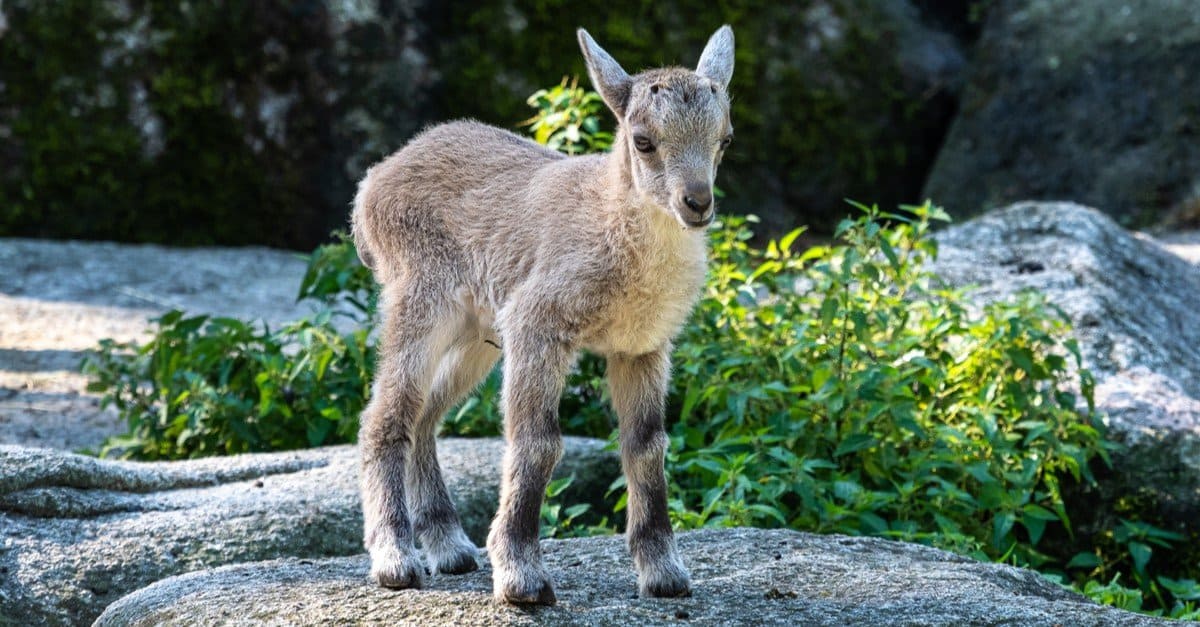
A baby ibex is most likely born in May after six months of gestation.
©RudiErnst/Shutterstock.com
The breeding season for these animals starts in late autumn to early winter. The males leave their bachelor herds to find females. Males often fight with other males to determine who can breed with the females. Despite the large horns of the animals, it’s rare for males to sustain serious injury from fights.
Once the female becomes pregnant, the gestation period is about six months. Most young are born around May. These animals usually have one kid per litter. It’s possible for the ibex to have twins and even triplets, but the latter is very rare. Twins make up about 20% of births.
The babies are called kids, and they reach sexual maturity at about 18 months. They are often left alone when young to hide from predators. How long they stay alone depends on how quickly they pick up handling the terrain. The young usually stay with their mothers for at least a year. However, females do not reach their full body size until about five or six years of age, and males don’t reach it until nine to eleven years. The animal’s horns keep growing throughout its life, which can be up to 20 years in the wild.
Ibex Population
The alpine ibex is now quite plentiful and over 30,000 individuals are thought to exist in the wild. In contrast, the Walia species may have only about 500 individuals left, which makes them endangered. The Iberian ibex count is around 9,000 members. The Nubian species likely has about 10,000 mature animals left, and the population is decreasing, which gives it a vulnerable status according to the IUCN.
View all 39 animals that start with IIbex FAQs (Frequently Asked Questions)
Are ibex carnivores, herbivores, or omnivores?
Ibexes are herbivores.
What is an ibex?
The ibex is a type of wild goat that lives in the mountains of Europe, the Middle East, Asia, and parts of Africa.
Are ibex and goat the same thing?
The ibex is a type of wild goat and one of the ibex species, the Bezoar ibex, is considered the main ancestor of the domestic goat. The alpine ibex is sometimes called a steinbock or bouquetin.
Do ibex make good pets?
The ibex does not make a good pet as it does not have the usual traits of a domestic goat. These animals are quite large with large horns and are not particularly friendly.
Can Ibex be domesticated?
An ibex raised from a young age could potentially be domesticated. However, the ibex is not a practical domestic animal. Despite the confusing name of the Ibex company that makes wool clothing, ibex species do not provide wool. The ibex has coarse thick hair like a goat and should not be confused with sheep species that provide wool.
Do ibex die from falling?
The ibex rarely dies from falling because they rarely fall. An ibex is more likely to die from a predator on flat terrain than to die from falling.
Are ibex endangered?
Some types of ibex are more endangered than others. The alpine ibex and Siberian ibex are considered of least concern.
Can you eat ibex meat?
Ibex meat is edible and similar to a goat.
What is a male ibex called?
Male ibexes are called bucks.
Thank you for reading! Have some feedback for us? Contact the AZ Animals editorial team.
Sources
- Wikipedia / Accessed May 29, 2021
- Live Science / Accessed May 29, 2021
- Britannica / Accessed May 29, 2021
- Animal Corner / Accessed May 29, 2021
- Facts And Details / Accessed May 29, 2021

